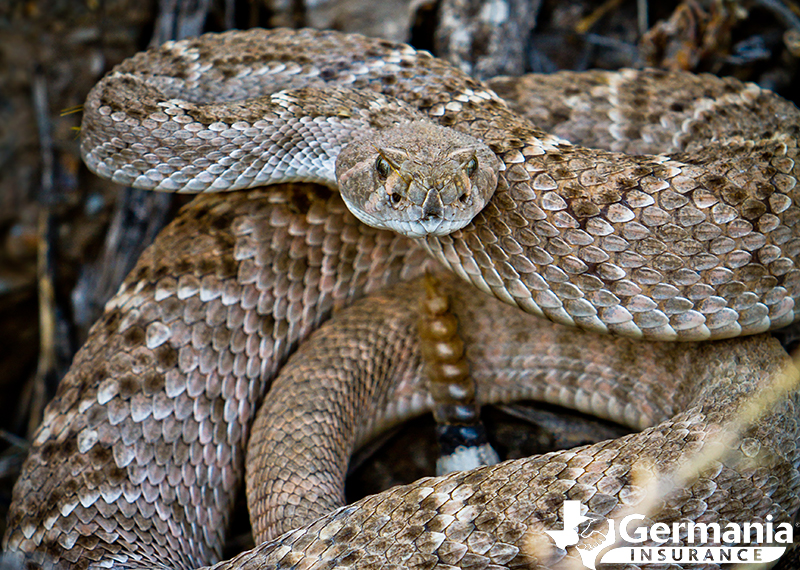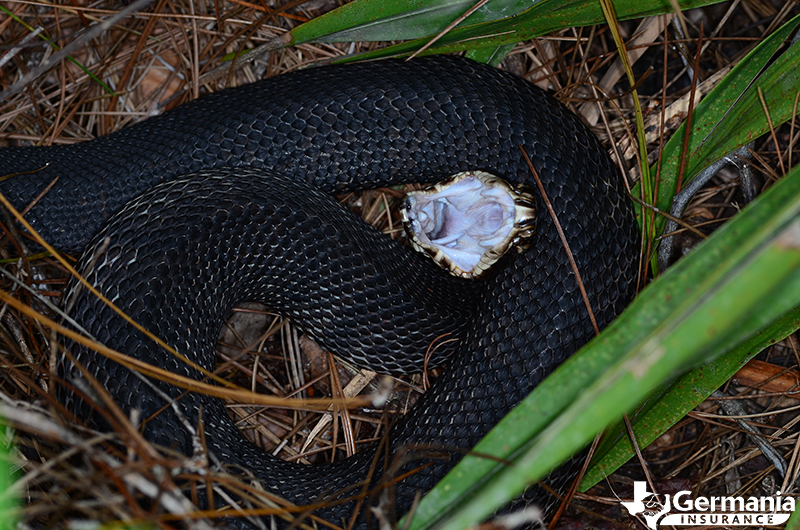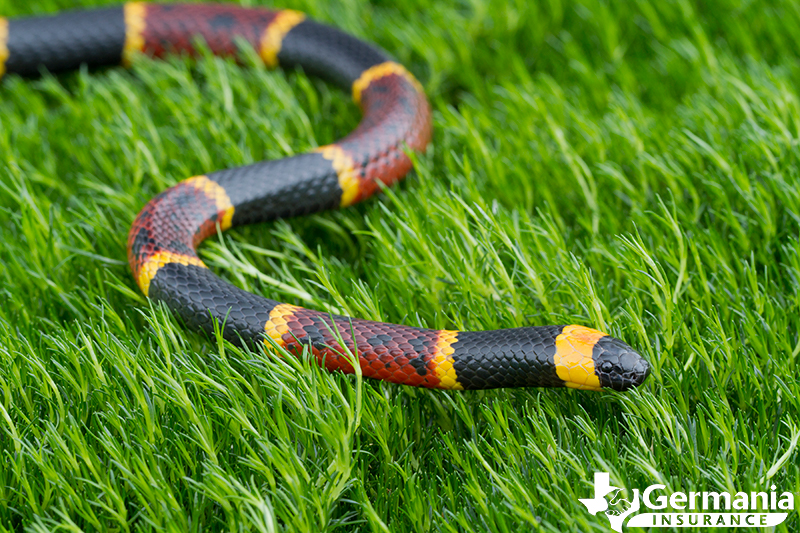Venomous or nonvenomous? Practice Texas snake safety and learn about the differences
Snakes are an important part of the ecosystem in Texas, but when our paths cross, the situation can become dangerous - for both of us! When it comes to snake safety in Texas, it's important to learn about the venomous and nonvenomous varieties, understand how to avoid them, and treat a snakebite should it occur.
Texas venomous snakes
Statistically, you’re more likely to die of a lightning strike than a snake bite. Even the most dangerous snakes tend stay away from humans, and they only bite when they feel they are in danger. They want as little to do with you as possible! The best way to avoid a bite is to give them space, and learning to identify them can help you keep your distance.
While there are 15 types of venomous snakes in Texas, there are four major venomous snake groups: rattlesnakes, cottonmouths, copperheads, and coral snakes.
Texas pit vipers
These venomous snakes have triangular shaped heads with narrow eyes, and
their patterns are typically distinctive. The "pit" aspect of their name refers to an opening on either side of their heads in between their eyes and nostril, which they use to sense the body heat of prey.
 Rattlesnake.
Rattlesnake. Rattlesnakes are a common and iconic type of venomous snake in Texas. As the name suggests, rattlesnakes use their specialized hollow tail as a warning to potential predators.
There are a number of sub-species of rattlesnakes in Texas, which come in a variety of patterns and colors:
Identifying a rattlesnake based on colors and patterns alone can be difficult. Fortunately, they all have rattles! However, while their rattles are normally used to warn predators, they also can make it more difficult for them to ambush prey and might even attract more bold predators. That's why some herpetologists believe that certain rattlesnakes are starting to
use their rattles less, and may even be losing them altogether.
 Cottonmouth.
Cottonmouth. Cottonmouths, also known as "water moccasins," are another one of the three pit vipers in Texas. While most of them are almost completely black, they have been known to have gray, tan, and even yellow hues to their scales. They can often been seen with dark spots or stripes, but these patterns are usually more common in juveniles.
They get their name from the white tissue inside of their mouths, which they typically show off when they feel they are in danger. While their bite is certainly painful, it is rarely fatal, especially if treatment is given.
Cottonmouths are partially aquatic snakes and can be found in areas with plenty of water, such as swamps, marshes, lakes, and streams.
 Copperhead.
Copperhead. Copperheads are the third pit viper species in Texas. Aptly named, they are known for their brown, reddish color with darker bands and patterns along their backs, similar to the color of dried leaves.
While the copperhead is responsible for more snake bite cases than any other species in North America, their venom is the least toxic. For this reason, bites are rarely fatal for humans.
North American elapids, or the cobra family

Coral Snake. The coral snake actually belongs to the same family as the cobra and is the only species of its kind in Texas. Coral snakes have the second-strongest venom of any snake, and are the most venomous snakes in Texas. However, unlike pit vipers, they have to hold onto and chew their prey in order to effectively deliver their venom.
So how deadly are coral snakes? Despite the fact that their venom is strong, they are considered less dangerous than rattlesnakes because of the method of delivery. Their fangs are small, making it difficult to truly puncture skin, and most bites occur when trying to handle them.
Still, their bites can be incredibly painful and can result in cardiac arrest if medical attention isn't administered. While there have been no reported deaths in Texas from coral snake bites since the antivenom was invented, there is a
massive shortage of the life-saving cure in the United States.
Coral snakes can be fairly easily identified by their red, yellow, and black bands of color. If you've ever heard the rhyme, "Red touch yellow, kill a fellow, red touch black, you're okay, Jack," it's fairly accurate with a few exceptions. This is used to help you distinguish a coral snake from other snakes that mimic it's pattern to ward of predators, such as the scarlet king snake. However, coral snakes have been known to be much darker, making it difficult to tell apart their bands, and they can also be albino and have no color at all.
Texas nonvenomous snakes
While there are a limited variety of venomous snakes in Texas, there are almost too many species of nonvenomous snakes Lone Star State to count. There are those that look nothing like their venomous cousins, and some that try very hard to copy them. This can make identification difficult, but there are some features you can look to for help.
Looking for distinctive patterns and colors can be a good way to tell venomous and nonvenomous snakes apart. However, it is not foolproof. For example, the Rough Green snake, which is a bright green with a yellowish underbelly, bears no resemblance to any venomous snake in Texas.

But the bull snake goes to great lengths to mimic not only the appearance of a rattlesnake, but the behavior as well. While they don't have rattles, they will often coil and hiss in an attempt to trick predators into thinking they are more dangerous than they really are.
Size is not a good way to tell the two apart, but sometimes the shape can be. As mentioned, pit vipers typically have a more triangle-shaped head, but even this can be misleading. The aforementioned bull snake, as well as hog-nosed snakes, are known to flatten or flare their heads to replicate the triangular shape of a venomous snake.

With careful practice, you can learn to spot some of the differences mentioned above. However, when considering snake safety, the safest course of action is to give every snake adequate space as though they were venomous.
Snake precautions and prevention
Snake safety doesn't just mean knowing how to spot them, but knowing how to keep them away from places where you, your family, and your pets frequent. While identification is an important part of snake safety, it's equally essential to know how to keep them away from your home and how to handle an encounter in the wild.
Snake saftey at home
You may have heard of ammonia-soaked rags, moth balls, garlic, salt, and a variety of plants used to keep snakes away from your home. If you search online, you can find a number of home grown snake repellent solutions, and even some retail products. The truth is, however,
that there is no magic substance or device that can keep snakes out of your yard and away from your home.
While these remedies aren't effective, some of them can be downright harmful, not only for the environment, but for you, your children, and your pets. When trying to prevent snakes from wandering into your path, you should avoid the following:
- Mothballs
- Ammonia
- Sulfur
- Gas or diesel
- Other chemical snake repellents
Snakes tend to look for shelter and shade. This means tall grass, woodpiles, old brush — anywhere that they can hide and hunt for their food.
The best way to keep snakes out of your yard is to make your yard into a place snakes don't want to be. This means removing hiding places for snakes and making sure that the things snakes eat don't want to be there, either.
- Keep your lawn mowed and trim shrubs and trees.
- Keep storage sheds and garages as clean as possible.
- Remove shelter by moving stacks of wood, rocks, or other materials away from your home
- Do your best to remove rodent populations.
- Make sure cracks and holes into your home are sealed.
- Move bird feeders away from your home.
- Put perch poles up to attract owls and hawks, which are natural predators to snakes.
If you do encounter a snake, you should avoid killing it if at all possible. A simple squirt from a water hose will get them moving in the opposite direction. Remember, they don't want anything to do with you, and you are more likely to be injured when attempting to kill it.
Furthermore, snakes are an important part of the ecosystem and help maintain the natural balance by keeping the population of their prey in check. Without them, our homes could be overrun with mice and rats!
As long as you give snakes their space and make your yard an uninviting place for them, they will stick to their territory, quietly helping exterminating rodents that would otherwise invade your home.
Snake safety in the Texas wilds
While the methods above can keep you and your family safe from an unpleasant snake encounter at home, there are safety measures you can take to protect them from snakes while in the great outdoors:
- Wear boots and long pants.
- Stay on well-used trails if possible.
- Stay out of grass and away from thick brush and rock outcrops.
- Keep kids close and dogs on a leash.
- Walk with a pole or stick that allows you to push back grass and brush to better spot snakes.
If you hear an ominous rattle while out in the wild, stop and identify which direction it's coming from. Then, slowly back away. Regardless of whether you think the snake is venomous or not, for the sake of safety, keep your distance and make sure the snake has an escape route that leads away from you.
What to do if you're bitten by a snake
A venomous snakebite can be a serious medical issue. While symptoms vary based on the type of snake, it can cause difficulty breathing, loss of consciousness, and even slurred speech. If you, a family member, or a pet is bitten, it's important to treat it as quickly as possible. Unfortunately, the conventional wisdom for snake bite treatment has changed a lot over the years, and it can be difficult to know what the best, safest practices are.
While incisions, tourniquets, ice packs, and snakebite kits have all been advised in the past,
current experts do not recommend any of those methods as they can cause serious damage to the victim and make things worse. The best thing you can do is make sure that the victim is taken to an emergency room as quickly as possible.
If you can safely identify the snake, or snap a picture, this can help the medical professionals administer the proper antivenom (also called antivenin). Try to limit the victim's movement and physical activity and keep them calm on your way to the hospital. If they have any tight clothing, watches, rings, or bracelets, make sure to remove them as the swelling can cause them to restrict blood flow.
Venomous snakes don't always deliver poison when they bite. This is called a "dry bite" and they can be common. However, you should never wait for symptoms of a snake bit to take effect before seeking medical attention. In other words, always assume that it has delivered a dose of poison.
If you're certain that you've been bitten by a nonvenomous snake,
treat the injury like a puncture wound. Apply pressure to stop any bleeding, and clean the bite area well to prevent infection.
 When you’re filing a claim, great customer service is essential. Since 1896, Germania Insurance has been the Insurance Texans Trust for great coverage and outstanding customer service. But don’t take our word for it! Hear what our customers have to say.
When you’re filing a claim, great customer service is essential. Since 1896, Germania Insurance has been the Insurance Texans Trust for great coverage and outstanding customer service. But don’t take our word for it! Hear what our customers have to say.
For more information about our insurance products, request a free quote online, or reach out to one of our trusted agents today!
Read more: There's a lot to learn when it comes to homeowners insurance in Texas.
Read all about it here!